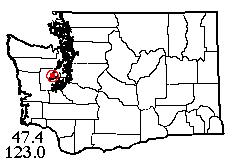
Spider Collector's Journal (10th page: 1999) Copyright © 2005 by Rod Crawford
As explained on the first page, most of these notes of fun (and not so fun) trips to collect spiders for research at the Burke Museum appeared in Scarabogram, newsletter of "Scarabs: The Bug Society," in their original forms. References to the editor mean me; most other persons mentioned are Scarabs members. Dates of field trips head each paragraph. Maps showing the location of sites within Washington state follow the grid system outlined in the Washington Spider Checklist. RETURN TO INDEX
 |
21 V 1999: Yr editor has actually been collecting in Washington this year. The first was on 21 May, when I guided Petra Hirschberger, visiting red-haired German coleopterist, on her first local trip. Petra had been studying European dung beetles (yes, I mean scarabs) with respect to the stridulatory sounds they make in their mating ritual. She was now spending a year in the USA for comparative studies on our dung beetles, and especially on some European species that have been introduced here. Have they developed new dialects? We went to the southwest corner of the Kitsap peninsula (a region Scarabs have visited a few times in the past, known for its open heath shrublands and unusual butterflies). En route we hoped to get some beetles in a sheep pasture, but the owner refused to let us entomologize among his sheep...wonder why? Our specific destination was a large wetland known on maps as "The Peat Bog," plus surrounding uplands. In a very short visit I got some interesting spiders, including a good series of Tetragnatha caudata, a "stick spider" that looks just like a little twig. I found no Sphagnum where I was, but Scarab Kulzer reports there is some elsewhere in this bog. Petra found one of the introduced European beetles (one which she thinks hadn't been reported from Washington before) at horse dung, and writes: "The beetles I collected are very interesting for my stridulatory investigation, and they were also quite cooperative, so that I was able to get four pairs to sing and recorded them. ...My trip to Dallas was OK. The city is a nightmare, but I found five species of dung beetles in considerable amounts so that I can do some experiments with them."
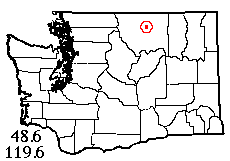 |
1-4 VI 1999: Last September, retentive readers may recall, I spent a week in Stehekin. This June, an opportunity presented to out-do myself by one syllable and spend a week in Sinlahekin! To be precise, the Sinlahekin Valley in Okanogan County, June 1-4. Bird, mammal, herp and bug folks from the Burke Museum combined forces for a field camp on Sinlahekin Creek near Blue Lake in this long, narrow, flat bottomed valley north of Conconully which drains northward, just inside the eastern Cascade foothills. Bird man Chris Wood preceded us, leaving a cryptic note at the lake as to where he'd camped. We finally figured out he was on the other side of the flooding creek from the road, at a campground reachable only by fording. It turned out that the creek (which comes down out of the hills near this point) had been split in two a half-mile upstream as part of some sort of abandoned mining operation, to rejoin just below the camp. So we were actually on an island, where we stayed for most of the 4 days.
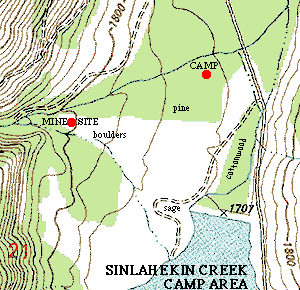 |
Diverse habitats abounded in this small area: a large dry meadow, becoming
wet down toward the creek fording point; a cottonwood forest along one branch
of the creek which had a lush grass and herb understory; on the slopes, Ponderosa
pine forest which grew after a fire perhaps 60 years ago (one of the largest
trees, a windfall, had 52 rings); large bouldery areas caused by flooding of
the streams; grassy glades among the pines; a drier section of cottonwoods along
the upper branch of the creek.
I even located a
very small area of sagebrush-rabbitbrush in the valley bottom (perhaps 15 full
grown sage bushes plus a few small ones), and from this tiny isolated habitat
collected a number of the spiders common in open sagebrush habitat. Conclusion:
there must have been a nearby source of colonists, perhaps a large sagebrush
tract just over the ridge from us.
Manmade habitats
were provided by hard-to-find, tumbledown shacks of the old miners, and (as
usual) by the camp outhouse. On the third day I was working along the stream
bank just below where I'd seen one of the ruined shacks, and was amazed to find
a door in the side of the ravine! Aha, I thought, it's the mine! No such luck,
just two small underground rooms about a meter high supported by timber much
sounder than that on the surface. These cool, dark chambers (probably a food
or equipment cache) were empty of contents...but not of spiders! Two species
characteristic of such places were found.
One day, just like
in a Western, an extensive herd of cattle were driven south along the road by
cowboys on horses, right across the creek from where I was sifting cottonwood
litter. The weather was great, partly cloudy at first, gradually becoming sunny
by the end. Rain threatened a couple of times but failed to materialize.
Ah yes, the spider
fauna. Well, the heavy snowpack and wet spring apparently made the early spring
fauna lag behind and meet the late spring fauna, much to this collector's benefit.
The grand total for the camp "island" was 70 species, my best single-area
sample from eastern Washington to date (and I've rarely done better even in
the "spider heaven" of western Washington).
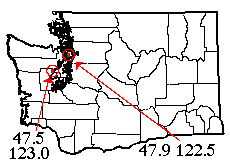 |
27 VI 1999: On June 27, I and Jim Arnold (spider collector visiting from Virginia) went on a day trip with Jim's wife, who was here attending a mammal society meeting. We visited Point No Point (a name which delighted the visitors greatly) at the north tip of the Kitsap Peninsula. There's a county park here around the historic lighthouse, with public beach, beach meadow, small salt marsh which grows some Dracula-like mosquitoes, and trails in the maple-alder forest atop a bluff. We enjoyed decent collecting in the forest and got some interesting species as well in the upper beach and beach meadow habitats, but I was appalled at the extent to which the beach meadows here are overgrown with Himalayan blackberry! This plant is well on its way to destroying all open space near human dwellings throughout the Puget Sound area. Can't someone at least declare it a noxious weed?? We also visited Waketickeh Creek in the Hamma Hamma River valley (oh, these quaint Washington place names!) to collect from the thick moss on trees. Woe, a bit of blackberry even there!
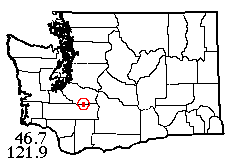 |
22 VII 1999: My two most recent collecting trips were in the pleasant
company of Petra Hirschberger, visiting German dung beetle researcher. Both
were aimed at collecting live specimens of the beetle Aphodius rainieri,
described in 1970 by Melville Hatch (the late High Scarab) from horse dung at
Paradise on Mt. Rainier. I knew of two areas just outside the National Park
with habitats similar to those of Paradise, and we visited both on different
days. On July 28, Petra and I headed for Mt. Beljica and Beljica Meadows, located
between Ashford and the national park boundary. Accompanying us was Seattle
Times reporter Bill Dietrich and a photographer, doing a story on spiders which
will appear soon in the magazine section of a Sunday paper near you. [I wouldn't
have mentioned this had I known they'd use a full page picture of me with my
shirt cinched up above my waist and my tongue sticking out!] I'd been to the
spot once before, in the late 1970s, and had no trouble finding the trailhead
and the right trail. It dawned on us that we might be in for an atypical day
when, approaching the first meadow, we had to traipse through a snowfield...at
only 4400 feet elevation. The meadows themselves were relatively snow-free,
but only just; all the grass was still plastered down from the winter snowpack,
ground was soggy from meltwater, and just a few spring flowers had come up.
Unfortunately for Petra, no one had yet taken any horses on this only just-cleared
trail, and there was no recent dung to be found. She found a couple of desperate
beetles around some very old dung from last year, but not enough to pursue her
project (to record the sounds made by males to attract mates!). The spider collecting
wasn't bad, with spring species one might have expected in May, not late July.
I accomplished my goal of boosting my previous inadequate sample from the site
to over 20 species. The journalists got enough to satisfy them, but poor Petra
still needed some beetles!
Fortunately, on
the way home we passed a field along the highway with both a horse and a single
cow (black Highland breed) owned by a friendly family who looked on with amusement
as we combed the pasture, tearing apart the freshest cowpies and horse dung
for beetles. Three Aphodius species were taken in some numbers, plus
an odd beetle in the water-beetle family Hydrophilidae that belies its relationships
by inhabiting dung. Bet we were the main topic of conversation in that neighborhood
for days afterward!
 |
29 VIII 1999: A month later, on August 29, Petra and I went out to have
another try for Aphodius rainieri. This time we went to Corral Pass,
one of the higher points in the Mt. Rainier area reachable by a decent road,
and just outside the NE entrance to the park. After our previous experience,
we had to wonder: would there be any dung? Fortunately, I happened to learn
that Scarabs Ulsh and Nunnallee were going to the same spot for butterflies
with Jon Pelham on the previous day. Now, Petra keeps a large supply of frozen
sheep dung in little yogurt containers in a freezer to feed her laboratory subjects.
I obtained 6 of these and handed them over to Pelham the night before the butterfly
trip. On Saturday the 28th, which fortunately was a nice bright butterfly day,
he emptied them out (doubtless with appropriate comments) near a landmark hitching
post in the area of the Corral Pass parking lot.
Late Sunday morning,
Petra and I arrived at the same spot amidst clouds, mist and threatening drizzle.
A little effort sufficed to locate the sheep dung samples. Half of them were
almost untouched, but beetles had aggregated on the other three, and these were
so full of tunnels they resembled Swiss cheese. Among the beetles recovered
was the elusive A. rainieri; loud cheers! Elsewhere, Petra also located
some horse dung and even some natural deer dung (have you ever tried to search
a forest for fresh deer dung?) In all, 5 species of Aphodius dung beetles
were taken, making this a very successful trip.
Meanwhile, I hiked
southward on a well-marked trail to nearby Castle Mountain (6330 feet elev.)
to collect spiders on the upper slopes. I had little more than an hour's actual
collecting before I had to admit that the gradually increasing drizzle was verging
on actual rain. Giving up on net- and sifter-based collecting, I worked my way
up slope turning rocks. Finally deciding to leave, I noticed I was just a little
ways below the actual summit. It would have been too bad to go off without actually
"climbing the mountain," so up I went. Lo and behold, the relatively
easy climb to the actual peak brought me to a point where, right on the other
side of the pinnacle, was a great big vertigo-inspiring cliff. Backing off in
a hurry, in the increasing fog I started back down, in my haste picking the
wrong ridge of the mountain for the purpose! Fortunately I discovered my mistake
in time to avoid "Spider Man Lost In Mountains" type headlines. The
spiders collected nicely complemented my previous samples from this area (in
1993 and 1995 trips with Louise Smith), including my ninth new species of the
microspider genus Scotinotylus.
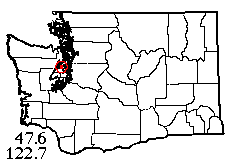 |
29 IX 1999: I'd been asked to participate in a grant proposal involving a large project at Big Beef Creek Field Station, a UW-owned research site on the Kitsap shore of Hood Canal. Never having been there, I hitched a ride on Weds. September 29 with Karen Schmitt, one of the site's part-time managers. A really beautiful sunny day (you dimly remember those, don't you?). Since the site is only a little way from the town of Seabeck I'd sadly expected much of it to be taken over by the usual nasty exotic plants (ivy, blackberry, Scots broom, etc.) but in reality only small areas were occupied by these; most of the vegetation is still natural. The site includes the deep canyon of Big Beef Creek (a salmon stream), conifer forest on the sides and ridges, alder-salmonberry forest in the wide gravelly riparian bottomlands, and a good-sized estuarine meadow crossed at its outer edge by the Seabeck Highway on a causeway. Good spider catches were taken in all these habitats, but I haven't looked at them yet. [Yes, there is also a Little Beef Creek. The area was apparently used for cattle sometime in the 19th century, thus the meaty stream names.]
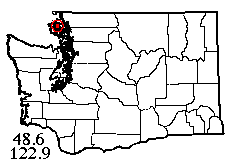 |
8-10 X 1999: On the weekend of October 8-10, I had my first [and last,
as it turned out] experience of teaching a spider class for the North Cascades
Institute. It being a bit late in the year to work in the North Cascades proper,
we'd reserved space at the Four Winds / Westward Ho youth summer camp on Orcas
Island. The grounds here occupy a surprisingly good-sized chunk of the island
and include a farm, forest, hills, pond, and shoreline with lots of habitats,
some more disturbed, some less so.
Not long before
the scheduled dates of the class, a ferry lost power and crashed into the Orcas
dock, smashing it to smithereens! So I and Saul Weisberg (director of the institute
and friend of Scarab Pyle) had a several hour wait for the temporary ferry in
Anacortes on Friday, where among sporadic drizzle we took hikes in the surprisingly
natural wetlands and woods around the ferry dock area, which is well away from
the town proper (no doubt to eliminate competition for the usual pricey dockside
snack bar).
Fortunately, Saturday
dawned clear. In between lectures and lab work, I led the class out into the
field, collecting at 5 sites on the Four Winds grounds (open forest around the
cabins; seashore forest edge; hilltop salal thickets; meadow and conifers near
an orchard where we had lunch, complete with maggot-free apples fresh off the
tree!; and a pond largely surrounded by exotics (canary grass and blackberry).
In all we took 40 spider species from the grounds. On Sunday, a reduced group
left the camp and visited an oak forest, a Spiraea-cattail marsh near
Killebrew Lake bog, and a rocky hillside above the ferry dock, bringing total
species for the trip up to 61. And the participants even learned something,
at least I hope so. We found no Sphagnum at the bog, and I later heard
a rumor that this outstanding site was ruined in a supposedly controlled burn
by the state managers. I'm glad I sampled it while
it was in its prime!
 |
XI 1999: I had one trip each in November and December '99, both in company with dung-beetle hunter Petra Hirschberger (our November speaker). Since regular dung beetles aren't active in winter, the idea was to hunt for a member of the group found on ocean beaches, Aegialia blanchardi, which feeds on beach debris and may very well transmit a "song" through sand as its relatives do through dung. We planned to hunt for these in the Westport area in November, and I had an ideal spot in mind where I'd collected spiders in some nice dunes and beach at Cape Shoalwater in 1987. Well, the trip was put off from day to day because of foul weather reports, and we finally went on a day when the weatherman predicted a brief let-up in the succession of storm systems. No such luck! It rained steadily all day. Anyway, we tried to find my lovely 1987 collection site. It ain't there any more! The very land it was on (including a number of houses) has been eaten by the sea, and the coast highway itself has been re-routed inland (the old road now ends rather abruptly). Well, forget that. On to Twin Harbors State Park, where Petra had found at least one live Aegialia previously. No such luck this time. Ever try sifting sand in the rain? I could have collected a few spiders, but with no prospect of a proper collection under existing miserable conditions, I didn't even bother. Only bright spots of the trip: fish and chips in Westport, and a nice twilight walk through the Mima Mounds on the way home.
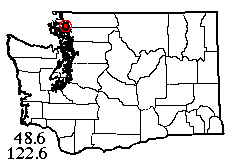 |
30 XII 1999: The last field trip of the '90s was considerably nicer. Petra's friend Karin Schütt, German spiderwoman, was visiting, and the three of us headed north to Lummi Island on December 30. This island, north of Bellingham and east of the other San Juans, is reached by a county (not state) ferry that runs hourly and takes a mere 6 minutes! The parts of the island reachable by road are largely private but there is one public beach a few blocks south of the ferry dock, and a public hiking trail (partly through private land) up Lummi Peak (all of 1665 feet high). Plenty of public land on the roadless half of the island, reached mainly by boat. Tide was in on the beach, so we went a little way up the hiking trail and settled down in a nice dry spot under a cedar tree to collect spiders. With Karin and Petra's help I gathered 32 species in under 4 hours, which is good (though not exceptional) for the time of year. Karin was amazed to see so much spider activity -- apparently in the Berlin area spiders pretty much shut down in the winter. On the way home we stopped at the island beach, and also at one of my favorite beaches, Clayton Bay off Chuckanut Drive south of Bellingham. No Aegialia here either, but at least we were able to have a fair try for them. Petra was a good sport about it, too... [Anyone wanting to learn more about Petra's dung beetle work should have visited her personal web site while it was still there. Perhaps it will return some day.]
This page last updated 7 April, 2024